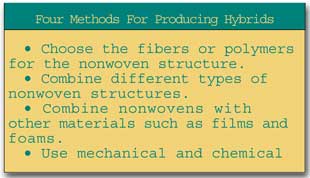A Hybrid Market
New developments in nonwovens are stemming more from evolution than from
revolution. New product research and development is the lifeblood of almost every
business. However, there is no simple route to developing new products. With few exceptions, most
new products result from evolution in technology rather than revolutions in technology. Many new
products are developed by combining existing materials or processes to form a new product which is
a hybrid. Hybridizing can then be considered as a process for developing new products. It can be
considered that whole field of nonwoven technology as a hybrid, since nonwoven technology
represents the combining of several basic technologies such as textiles, paper and polymers.

Spunbond/Meltblown (SMS) ProductsKimberly-Clark has been the pioneer in combining
meltblown nonwovens with spunbonds to develop a whole family of new products. The SMS products that
have been developed by using a layer of meltblown polypropylene sandwiched between two layers of
polypropylene spunbond are used for surgical wrap and for limited use in protective clothing and
for automobile protective covers. Another development using combination technologies by
Kimberly-Clark is their Coform system. This system creates a blend of meltblown polypropylene
microfibers and powdered materials which is then formed onto a spunbonded carrier sheet.The
semi-molten meltblown fibers, combined with the pulp and powdered materials, acts as a
chemical-free adhesive system.The combination web formed by this process becomes a dimensionally
stable, absorbent structure, even when it is wet. Thinsulate3Ms Thinsulate is used for apparel
and footwear insulation. This product is made by incorporating a carded web of heavier denier
crimped polyester fibers into a microdenier meltblown polypropylene web. The finer microdenier web
provides the insulation properties and the carded web provides resilience for the composite
structure. Water Blocking TapesThe swelling layer consists of a lightweight nonwoven coated
with a chemically pure cellulose that is aerodynamically applied to become a super absorber.
Super-absorbent fibers in the form of nonwovens produced by dry-laid processes are also used in
this application. The backing layer is a polyester nonwoven such as a spunbond, or a dry-laid
fabric reinforced with a polyester scrim.Many communications cables and fiber-optic cables contain
a paraffin-like, highly viscous filling compound as a water-blocker in the cable core assembly. A
swelling tape is applied to the filled cable core to seal off any cavities under laminated
sheaths.To prevent the petroleum jelly from penetrating the nonwoven and impairing its swelling
properties, polyester film is laid longitudinally over the cable core assembly and to wrap the
swellable nonwoven around it in a second manufacturing step. Printed Circuit BoardsTo create a
circuit board, a series of procedures must be followed. A circuit board is made by producing an
isotopic aramid nonwoven, impregnating the nonwoven with the crosslinking resin system, drying the
prepreg and obtain B stage crosslinkage, laminating it with copper foil in a roller laminator under
clean room conditions, and then hardening the composite material for five hours at 120oC.A major
advantage of this system is that the layers are bonded without using a solvent-containing
adhesive. Battery SeparatorsComposite products have been developed for open systems of
nickel-cadmium secondary cells. These cells are used in airplanes, rail vehicles and emergency
generating sets. The electrolyte carriers used are polypropylene or polyamide nonwovens, combined
with cellophane films or hydrophilic polypropylene membranes. Filtration ProductsCartridge
filters can be formed by meltblowing or spray spinning techniques. Celanese Fiber Co. developed the
Hytrex cartridge filters by using a spray spinning technique to produce a shaped cartridge filter
of varying density. The Hytrex process and trademarks were sold to Osmonics Inc. which now markets
these filter products. The Pall Corporation produces shaped cartridge filters by a modified
meltblowing technique. Automotive ProductsThe application of polyethylene to jute carpet
backed automotive carpeting to aid in its forming was an important development in the 1960s.
Freudenberg Spunweb Co. has successfully introduced their Lutradur spunbonded polyester fabrics for
moldable automotive carpeting.The high strength and ease of molding of the Lutradur permits the
carpeting to have a deep draw configuration without encountering problems with punctures from high
heels or similar hazards.Freudenberg in Germany developed a molded sound-absorbing automotive
engine cover using polyester nonwoven fabric. Freudenbergs pleated polyester nonwovens are now used
for air filtration media for car interiors.DuPont has done extensive work in developing moldable
automotive and tractor seating fabrics that incorporated their Lycra® spandex to facilitate fabric
molding. Molding Of FabricsCutting and sewing have been the traditional methods of joining and
shaping textile fabrics into three-dimensional shapes.The felting of animal fibers into end items,
such as hats, was one of the earliest methods of directly forming and molding fibers into a final
product. Felts are also made in block form and other shapes by felting the wool or other animal
fibers within a shaped form.Until thermoplastic fibers became available, it was not possible to
directly form or shape fibers other than through felting. Garment MoldingGarment molding
presents one of the most challenging areas for development of fabric molding technology. In the
early 1970s, Teijin of Japan developed techniques for molding womens dresses using tubular
double-knit polyester fabrics.With the increasing array of nonwoven fabrics now available, it is
expected that molding and forming will continue to grow for specialty products such as automotive,
filtration and other industrial products.The commercialization of limited use and disposable
garments using molding technology for hospital/medical and clean room applications is also expected
to increase.
August 1999




